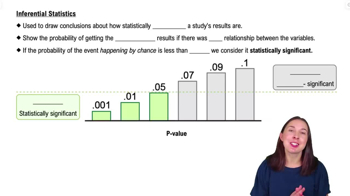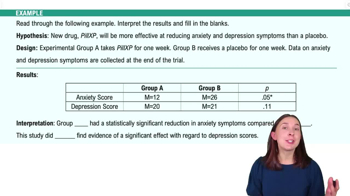Table of contents
- 1. Introduction to Psychology1h 43m
- 2. Psychology Research2h 20m
- 3. Biological Psychology2h 41m
- 4. Sensation and Perception28m
- 5. Consciousness and Sleep32m
- 6. Learning41m
- 7. Memory34m
- 8. Cognition37m
- 9. Emotion and Motivation35m
- 10. Developmental Psychology33m
- 11. Personality48m
- 12. Social Psychology41m
- 13. Stress and Health41m
- 14. Psychological Disorders44m
- 15. Treatment47m
2. Psychology Research
Evaluating Research Findings
Struggling with Psychology?
Join thousands of students who trust us to help them ace their exams!Watch the first videoMultiple Choice
What does the third-variable problem refer to in correlational research?
A
The presence of an unmeasured variable that may influence both variables being studied.
B
When you examine more than three variables, correlational research becomes unreliable.
C
The difficulty in determining if a correlation is positive or negative.
D
A common error that can occur in correlational research when a sample size is too small.
 Verified step by step guidance
Verified step by step guidance1
Begin by understanding the concept of correlational research, which involves examining the relationship between two or more variables to determine if they are associated.
Recognize that the third-variable problem refers to the possibility that an unmeasured variable may be influencing both of the variables being studied, potentially leading to a spurious correlation.
Consider how the presence of a third variable can create confusion in interpreting the results of correlational research, as it may be the actual cause of the observed relationship between the studied variables.
Understand that the third-variable problem highlights the limitation of correlational research in establishing causation, as correlation does not imply causation.
Reflect on the importance of controlling for potential third variables in research design to ensure more accurate and reliable conclusions about the relationships between variables.

 6:00m
6:00mWatch next
Master Descriptive Statistics – Measures of Central Tendency with a bite sized video explanation from Hannah Gordils
Start learningRelated Videos
Related Practice















![Ethical Guidelines in Psychology [AP Psychology Unit 1 Topic 6] (1.6)](https://img.youtube.com/vi/ilq2nGO7_QA/mqdefault.jpg)





























